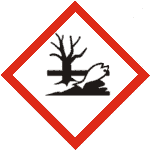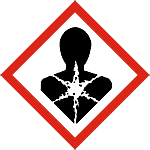Symbol |
Abbreviation |
Hazard |
Description of hazard |
(Physicochemical) |

|
E |
explosive |
Chemicals that explode. |

|
O |
oxidising |
Chemicals that react exothermically with other chemicals. |

|
F+ |
extremely flammable |
Chemicals that have an extremely low flash point and boiling point, and gases that catch fire in contact with air. |

|
F |
highly flammable |
Chemicals that may catch fire in contact with air, only need brief contact with an ignition source, have a very low flash point or evolve highly flammable gases in contact with water. |
(Health) |

|
T+ |
very toxic |
Chemicals that at very low levels cause damage to health. |

|
T |
toxic |
Chemicals that at low levels cause damage to health. |

|
Carc Cat 1 |
category 1 carcinogens |
Chemicals that may cause cancer or increase its incidence. |

|
Carc Cat 2 |
category 2 carcinogens |

|
Carc Cat 3 |
category 3 carcinogens |

|
Muta Cat 1 |
category 1 mutagens |
Chemicals that induce heritable genetic defects or increase their incidence. |

|
Muta Cat 2 |
category 2 mutagens |

|
Muta Cat 3 |
category 3 mutagens |

|
Repr Cat 1 |
category 1 reproductive toxins |
Chemicals that produce or increase the incidence of non-heritable effects in progeny and/or an impairment in reproductive functions or capacity. |

|
Repr Cat 2 |
category 2 reproductive toxins |

|
Repr Cat 3 |
category 3 reproductive toxins |

|
Xn |
harmful |
Chemicals that may cause damage to health. |

|
C |
corrosive |
Chemicals that may destroy living tissue on contact. |

|
Xi |
irritant |
Chemicals that may cause inflammation to the skin or other mucous membranes. |
(Environmental) |

|
N |
dangerous for the environment |
Chemicals that may present an immediate or delayed danger to one or more components of the environment |

















